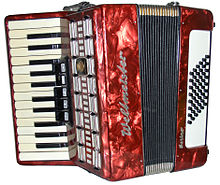Vogtland is a region in southwestern Saxony, bordering Thuringia, Upper Franconia and West Bohemia (Czech Republic). It is characterised by idyllic rolling hills cut through by river valleys and known for its handicraft traditions like lace-making and musical instrument making.
Cities
edit
- 1 Plauen , the region's "capital", known for its laces
- 2 Adorf , old town with half-timbered houses
- 3 Bad Elster , health resort with mineral spring, surrounded by wooded mountains
- 4 Klingenthal , town of musical instrument makers, especially known for accordions
- 5 Markneukirchen , centre of the "Musical corner", known for its instrument makers
- 6 Oelsnitz , former centre of textile industries
- 7 Reichenbach , trade town and seat of a philharmonic orchestra, near the landmark Göltzschtal bridge
Other destinations
editUnderstand
editThe Vogtland is a historical region that actually stretches over modern political borders including parts of the German states of Saxony, Thuringia and Bavaria as well as the westernmost bit of the Czech Republic. During medieval times, it was ruled by the Reeves (Vögte in German, hence the name) of Weida, Gera and Plauen. In the widest sense, parts of Western Thuringia (Gera), Upper Franconia (Hof) and Western Bohemia (Cheb) are part of the historical Vogtland, too. This article however focuses on the Southwestern part of Saxony.
Most of the Vogtland is hilly, its southern tip is covered by a low mountain range—the Elstergebirge (Elster mountains), named after the eponymous river that rises here—with heights of up to 759 metres. This is probably the most interesting part for tourists, offering several spas, winter sports and hiking trails.

In the late 19th and beginning 20th centuries, Vogtland was by far Germany's prime producer of musical instruments. At that time, about 50 % of the world's string instruments and accordions were produced here. Aspiring instrument makers from the whole country went to Markneukirchen or Klingenthal to apprentice to renowned masters and whole orchestras were equipped by workshops in Vogtland. During the German partition, the Vogtland still was East Germany's leading supplier of musical instruments, now also including synthesizers, but traditional handicraft was mostly replaced by industrial-scale production. Under capitalism and globalisation, most of the larger manufactories declined, but small and medium-sized traditional workshops have experienced a revival and are appraised by many musicians (e.g. Arcade Fire's Régine Chassagne has played "Weltmeister" piano accordions).
Get in
editBy plane
editThe nearest airports are Erfurt (140 km), Leipzig (145 km), Dresden (150 km) and Nuremberg (170 km). The next major international airport is Munich airport (300 km).
By train
editNo high-speed or intercity trains serve the Vogtland. Its major rail line is the hourly "regional express" from Hof (30–45 minutes), Chemnitz (about one hour) and Dresden (two hours) that stops in Plauen and Reichenbach; complemented by the two-hourly EBX from Leipzig (two hours), Gera (one hour) and Hof to Mehltheuer and Schönberg. Arriving from further destinations, you will have to change in Nuremberg and Hof, Leipzig or Erfurt and Gera.
By car
editThe most convenient way to reach the Vogtland is by car using the Autobahn A 72 linking Upper Franconia (Hof, Bayreuth) and Southern Germany in general with central Saxony (Chemnitz, Leipzig, Dresden), that intersects the region from southwest to northeast. Both the Vogtland's "capital" Plauen and the most frequently visited region in its south is accessible via the B 92 road from Gera or the neighbouring Czech Republic (Františkovy Lázně, Cheb).
By bus
editWhile Plauen used to be served by a Nürnberg - Dresden bus up until mid 2016, that connection was withdrawn when Flixbus bought Postbus who ran that connection. As of November 2016 no public scheduled bus service to Plauen or any other point in the Vogtland exists.
Get around
editSee
edit

- Göltzschtalbrücke, the 78 metre-high, 29-arched rail viaduct over the Göltzsch river is the largest brick-built bridge in the world and the region's symbolic landmark. At the time of its completion in 1851, it was also the tallest railway bridge in the world.
- Vogtland museum in Plauen
- Show embroidery, Plauen
- Round church of Klingenthal
- Spa building and gardens of Bad Elster
- Musical instrument show workshops in Markneukirchen
- Bismarck tower, Markneukirchen
- stalactite cave Syrau
- show mines: alum mine Plauen or "Grube Tannenberg" in Schneckenstein (8 km north of Klingenthal)
Do
edit- Skiing in the Elster mountains of Upper Vogtland
- Hiking
- Cycling, mountainbiking and E-biking (e.g. at mountainbike park Schöneck[dead link])
- Theater Plauen-Zwickau (formerly Vogtland theater), Plauen
- Vogtland philharmonic orchestra, Greiz and Reichenbach
- Annual events
- Kleine Tage der Harmonika[dead link] competition for young accordionists (early March)
- Mozart weeks[dead link] in Bad Elster (late March to early April)
- International accordion competition Klingenthal (May)
- International jazz days Bad Elster (August)
- Mundharmonika live harmonica festival in Klingenthal (3rd weekend in September)
- Chursächsische festival [formerly dead link] of classical music in Bad Elster (September to early October)
- Winter dreams festival in Bad Elster (November to February)


